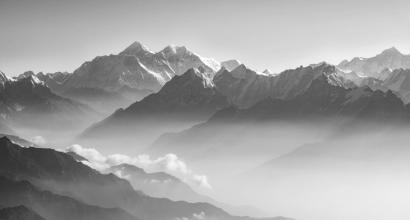This is also called the bhramara-kīṭa-nyāya. A bee captures a worm with the intention to eat it, and keeps it in front of it, waiting for the vim of the worm to wane. The scared worm stares intently at the bee. Thus, the weak worm gazes at the strong bee continuously meditates upon its form and gestures. Gradually, due to this meditation upon the bee, it is said to become a bee itself.
kīrtau kīrtau nas-tadākāra-vṛtttīḥ ।
vṛttau vṛttau saccidānanda-bhāsaḥ ॥
This is the dissolution of oneself — giving up jīvatva.
Another mahāvākya of the advaitins is —
ahaṃ brahmāsmi
-Bṛhadāraṇyakopaniṣad 1. 4.10
The meaning of this is dissolution of oneself. This thing called ‘I’ is not separate from Brahma. It is within Brahma. “līye parabrahmaṇi’’ (‘I’ merge into Brahma) is the essence. Here, Brahma means everything — the sum total of whatever exists in reality. The inner meaning of Brahmāham, sarvo’ham is the dissolution of ego and a separate identity — that I am not separate from Brahma, I am not different from ‘everything’. That is Advaita. It is not establishing one’s identity or elevating one’s ego; it is the giving up of one’s identity ; it is the dissolution of one’s identity.
A relationship similar to what is explained by the three matas is naturally found between a husband and a wife In all unbroken families.
In daily chores of a house, the jobs of a woman differ from those of a man. In matters of cooking and cleaning, she is the servant and he is the master. In matters of earning money and taking care of the family, he is the servant and she is the mistress[1]. In this way, daily life is structured around Dvaita. The mutual love, respect, and timidity they have for each other gradually erode the insolence of his or her ego; prasāda of the form of acceptance is obtained.
In the same couple, we can see the relationship of aṃśa-aṃśi (part-whole) or śeṣa-śeṣi (body-embodied ātmā) during dhārmic rituals or worship or during wedding celebrations or guest hospitality. Neither among the two can work independently. Both of them are required, and are required together. The present work cannot be completed with only one person. Collaboration is required here. It is the way of Viśiṣṭādvaita. While experiencing the greatness of Bhagavān, the ego of the jīva loosens and falls off. That is mukti.
Now let us look at the process of Advaita. The example of blissful matrimony applies here as well. In times of extreme intimacy, their separate identities are forgotten. They feel “I am you, you are me”. The remembrance of I and you does not exist at that time. This is the complete dissolution of oneself. Indeed, when the jīva-ness of the jīva vanishes, only the ātmā remains[2].
tatra ko mohaḥ kaḥ śokaḥ ekatvam anupaśyataḥ ॥
·Īśopaniṣat, 7
Thus, in the same matrimonial relationship, the feelings of Dvaita, Viśiṣṭādvaita and Advaita are all experienced, depending on the time and circumstances.
The great seer, Madhusūdana-sarasvatī has summarised in this verse that all the three matas are paths towards worshipping Bhagavan.
tasyaivāhaṃ mamaivāsau sa evāham-iti tridhā ।
bhagavaccharaṇatvaṃ syāt sādhanābhyāsa-pākataḥ ॥
This is the path of harmony.
- “tasyaivāhaṃ” (tasya+eva+aham): I belong to Bhagavān. I don’t own anything, I am dependent on Bhagavān, I am his servant. I am obedient to him. This is Dvaita.
- “mamaivāsau” (mama+eva+asau): Bhagavān is mine. A baby thinks that his mother belongs to him alone, and that only he has rights upon her. The word ‘eva’ here means that all of Bhagavān belongs to the bhakta. This is the pinnacle of love. Here there is remembrance of ‘I’, and the feeling of a separate identity. But beyond this, there is satisfaction that one is within the other. This is Viśiṣṭādvaita.
- “Sa evāham” (saḥ+eva+aham): I am he ; he is I. There are no two entities here. They are not different. There is no second one. This is Advaita,.
All the above three culminate in the same object. The author of Advaita-siddhi[3] especially treats all three equally. The reason for the existence of three is due to differences in the effort and practices of the bhaktas.
Let us take another example. Water is present in wells, rivers, and oceans. However, water in ponds and wells is not directly related to water in the ocean. When it rains and the ground becomes wet, water might seep into the well through the earth and thus, there might be a natural connection forged between this water and water in the ocean through internal orifices of the earth. Apart from such occasional and indirect connections, wells are completely different from oceans. This is Dvaita.
River water is different from ocean water till it reaches the ocean. It is different in terms of motion, taste, and other qualities as well. However, when the river merges with the ocean, it loses its separate identity and appears as though it is an arm — a part — a subordinate aspect — of the ocean. This is Viśiṣṭādvaita.
Coming to the ocean, it absorbs rainwater poured by clouds formed from water collected from wells, tanks, and lakes by the rays of the sun; it receives water offered by rivers; it accepts rainwater that had fallen on the plains and in the forests, as well as effluent water from by city-dwellers and merges them in itself. The ocean, since time immemorial, ingests these three kinds of water and makes it its own. The ocean is like Brahma of Advaita.
Thus, if the followers of one mata view the followers of other matas with empathy, there will be no reason for any quarrelsome debates. One’s mode of worship is in accordance with one’s proclivities and training.
Just as sweet talk marks love between two people, quarrels might also signify love. There is a story in the Bhāgavata where Kṛṣṇa incited Rukmini to fight with him. A bhakta behaves the same way with Bhagavān. Tyāgarāja praised Rāma, singing “who is equal to you[4]?”; and also reproached him saying, “are you incapable?” The talk and behaviour is according to the mood at that moment.
The same is true of the worship of the divine. Those who are advaitins when logically analyzing philosophical theories become dvaitins and viśiṣṭādvaitins when they want mental satisfaction. A great example of this is the manner of Madhusūdana Sarasvatī, who authored the classic Advaita-siddhi.
dhyānābhyāsa-vaśīkṛtena manasā … tannīlaṃ maho dhāvati ॥
(see page 328).
The great favour Vedas and Vedānta have conferred upon philosophical seekers is freedom in the matters of personal worship. This is also in the Gītācharya’s slogan :
yo yo yāṃ yāṃ tanuṃ bhaktaḥ śraddhāyā’rcitum-icchati ॥
-BG 7.21
Understanding a tattva means experiencing its meaning. Experience entails constant inquiry or contemplation. This requires śraddhā, which, in turn, is easily born where there is inborn interest. Hence, freedom in interest is the first facility needed for a philosophical seeker. It is natural to have śraddhā towards an object one is interested in. Worship becomes easier.
Because there is freedom in interest, there is freedom in worship also. Even among ardent vaiṣṇavas, some love the form of Kṛṣṇa more ; some love the form of Rāma and yet others love the form of Narasiṃha. Among śaivas, some like the form of Gaurīśaṅkara, some like Naṭarāja. Among the devotees of Devī, some love the form of Lalitā, some others love the form of Durgā. Just as taste is the main driver among the six rasas of food in a meal, taste is an important driver in the worship of the divine form of one’s choice.
In the third chapter of the Brahmasūtras called the Sādhanādhyāya, Bhagavān Bādarāyaṇa says that a worshipper has freedom of choice in the way of worship — ‘yāthākāmya’ —
aniyamaḥ sarvāsām avirodhaḥ ॥ 3.3.31
(Gist: There is no restriction for the upāsanā of any devatā.)tannirdhāraṇāniyamaḥ ॥ 3.3.42
(Gist: upāsanā mentioned as part of a yajña can be performed separately)nānā, śabdādi-bhedāt ॥ 3.3.58
(Gist: The upāsanās are different on account of their different names)vikalpo’viśiṣṭa-phalatvāt ॥ 3.3.59 etc.,
(Gist: There is an option to choose any upāsanā as all upāsanās culminate in the same result.)
When the objective is the same, and there are two or three paths reaching there, a sādhaka can choose whatever path he feels is more comfortable. That is the summary of the above sūtras. Even in the matter of the relationship between jīva and Brahma, there is no objection to any mata if we accept that an upāsaka obtains the object of his worship by choosing the path according to his proclivities and convenience.
In the four varṇas such as brāhmaṇas, etc., traditional, lineage-based rules apply to saṃskāras such as weddings. There is no such śāstra, however, for choosing one of the three matas for a lineage. Even so, the śraddhā and the ācāra followed by one’s father and grandfather creates a natural mindset in children and grandchildren, and they will find it easy to follow the same path. Even then, a person with independent thoughts is free to choose the path of a mata that appeals to him, and appears easy to him.
To be continued...
The present series is a modern English translation of DVG’s Kendra Sahitya Akademi Award-winning work, Bhagavad-gītā-tātparya or Jīvana-dharma-yoga. The translators wish to express their thanks to Śatāvadhāni R Ganesh for his valuable feedback and to Hari Ravikumar for his astute edits.
Footnotes
[1]We should remember that this was written in the 1960s, when women were mainly homemakers.
[2]See DVG’s “śṛngāra maṅgalam” — premādvaita
[3]Madhusūdana-sarasvatī
[4]Rāma nī samānamevaru











































